Field Emission Properties of Cu-Filled Vertically Aligned Carbon Nanotubes Grown Directly on Thin Cu Foils
Abstract
1. Introduction
2. Experimental Section
2.1. Cu@VACNTs Synthesis
2.2. Material Characterization
2.3. FE Measurement
3. Results and Discussion
3.1. VACNT Structure
3.2. Field Emission (FE) Measurements
3.2.1. Field Emission Theory
3.2.2. Field Emission Results
4. Conclusions
Supplementary Materials
Author Contributions
Funding
Data Availability Statement
Acknowledgments
Conflicts of Interest
References
- Berry, M.J. Helical microtubules of graphitic carbon. Nature 1991, 354, 737–740. [Google Scholar] [CrossRef]
- Yakobson, B.I.; Brabec, C.J.; Bernholc, J. Nanomechanics of carbon tubes: Instabilities beyond linear response. Phys. Rev. Lett. 1996, 76, 2511–2514. [Google Scholar] [CrossRef]
- Abdulhameed, A.; Wahab, N.Z.A.; Mohtar, M.N.; Hamidon, M.N.; Shafie, S.; Halin, I.A. Methods and Applications of Electrical Conductivity Enhancement of Materials Using Carbon Nanotubes. J. Electron. Mater. 2021, 50, 3207–3221. [Google Scholar] [CrossRef]
- Han, Z.; Fina, A. Thermal conductivity of carbon nanotubes and their polymer nanocomposites: A review. Prog. Polym. Sci. 2011, 36, 914–944. [Google Scholar] [CrossRef]
- Inam, F.; Yan, H.; Reece, M.J.; Peijs, T. Structural and chemical stability of multiwall carbon nanotubes in sintered ceramic nanocomposite. Adv. Appl. Ceram. 2010, 109, 240–245. [Google Scholar] [CrossRef]
- Lim, S.C.; Jeong, H.J.; Kim, K.S.; Lee, I.B.; Bae, D.J.; Lee, Y.H. Extracting independently the work function and field enhancement factor from thermal-field emission of multi-walled carbon nanotube tips. Carbon 2005, 43, 2801–2807. [Google Scholar] [CrossRef]
- Okwundu, O.S.; Aniekwe, E.U.; Nwanno, C.E. Unlimited potentials of carbon: Different structures and uses (a Review). Metall. Mater. Eng. 2018, 24, 145–171. [Google Scholar] [CrossRef]
- Kohls, A.; Maurer Ditty, M.; Dehghandehnavi, F.; Zheng, S.Y. Vertically Aligned Carbon Nanotubes as a Unique Material for Biomedical Applications. ACS Appl. Mater. Interfaces 2022, 14, 6287–6306. [Google Scholar] [CrossRef]
- Liu, Q.; Shi, X.; Jiang, Q.; Li, R.; Zhong, S.; Zhang, R. Growth mechanism and kinetics of vertically aligned carbon nanotube arrays. EcoMat 2021, 3, e12118. [Google Scholar] [CrossRef]
- Shi, W.; Plata, D.L. Vertically aligned carbon nanotubes: Production and applications for environmental sustainability. Green Chem. 2018, 20, 5245–5260. [Google Scholar] [CrossRef]
- He, Z.; Zhang, S.; Zheng, L.; Liu, Z.; Zhang, G.; Wu, H.; Wang, B.; Liu, Z.; Jin, Z.; Wang, G. Si-Based NIR Tunneling Heterojunction Photodetector with Interfacial Engineering and 3D-Graphene Integration. IEEE Electron. Device Lett. 2022, 43, 1818–1821. [Google Scholar] [CrossRef]
- Zhang, Z.Y.; Lee, C.S.; Zhang, W.J. Vertically aligned graphene nanosheet arrays: Synthesis, properties and applications in electrochemical energy conversion and storage. Adv. Energy Mater. 2017, 7, 1700678. [Google Scholar] [CrossRef]
- Liang, Q.; Yao, X.; Wang, W.; Liu, Y.; Wong, C.P. A three-dimensional vertically aligned functionalized multilayer graphene architecture: An approach for graphene-based thermal interfacial materials. ACS Nano 2011, 5, 2392–2401. [Google Scholar] [CrossRef]
- Chimowa, G.; Tshabalala, Z.P.; Akande, A.A.; Bepete, G.; Mwakikunga, B.; Ray, S.S.; Benecha, E.M. Improving methane gas sensing properties of multi-walled carbon nanotubes by vanadium oxide filling. Sens. Actuators B Chem. 2017, 247, 11–18. [Google Scholar] [CrossRef]
- Tyagi, P.K.; Singh, M.K.; Misra, A.; Palnitkar, U.; Misra, D.S.; Titus, E.; Ali, N.; Cabral, G.; Gracio, J.; Roy, M.; et al. Preparation of Ni-filled carbon nanotubes for key potential applications in nanotechnology. Thin Solid Films 2004, 469–470, 127–130. [Google Scholar] [CrossRef]
- Dorozhkin, P.S.; Tovstonog, S.V.; Golberg, D.; Zhan, J.; Ishikawa, Y.; Shiozawa, M.; Nakanishi, H.; Nakata, K.; Bando, Y. A liquid-Ga-filled carbon nanotube: A miniaturized temperature sensor and electrical switch. Small 2005, 1, 1088–1093. [Google Scholar] [CrossRef] [PubMed]
- Gao, Y.; Bando, Y.; Liu, Z.; Golberg, D.; Nakanishi, H. Temperature measurement using a gallium-filled carbon nanotube nanothermometer. Appl. Phys. Lett. 2003, 83, 2913–2915. [Google Scholar] [CrossRef]
- Nwanno, C.E.; Li, W. Aligned carbon nanotubes for lithium-ion batteries: A review. Nano Res. 2023, 16, 12384–12410. [Google Scholar] [CrossRef]
- Kiamahalleh, M.; Najafpour, G.; Sata, S.; Buniran, S.; Zein, S. Multiwalled Carbon Nanotubes Filled with Transition Metal Oxides as Supercapacitor Materials. Carbon 2010, 2, 3. [Google Scholar]
- Ugarte, D.; Stöckli, T.; Bonard, J.M.; Châtelain, A.; De Heer, W.A. Filling carbon nanotubes. Appl. Phys. A Mater. Sci. Process. 1998, 67, 101–105. [Google Scholar] [CrossRef]
- Zhang, X.X.; Wen, G.H.; Huang, S.; Dai, L.; Gao, R.; Wang, Z.L. Magnetic properties of Fe nanoparticles trapped at the tips of the aligned carbon nanotubes. J. Magn. Magn. Mater. 2001, 231, 9–12. [Google Scholar] [CrossRef]
- Gautam, U.K.; Costa, P.M.F.J.; Bando, Y.; Fang, X.; Li, L.; Imura, M.; Golberg, D. Recent developments in inorganically filled carbon nanotubes: Successes and challenges. Sci. Technol. Adv. Mater. 2010, 11, 054501. [Google Scholar] [CrossRef]
- Leonhardt, A.; Ritschel, M.; Kozhuharova, R.; Graff, A.; Mühl, T.; Huhle, R.; Mönch, I.; Elefant, D.; Schneider, C.M. Synthesis and properties of filled carbon nanotubes. Diam. Relat. Mater. 2003, 12, 790–793. [Google Scholar] [CrossRef]
- Baro, M.; Pal, A.R. One-step grown multi-walled carbon nanotubes with Ni filling and decoration. J. Phys. D Appl. Phys. 2015, 48, 225303. [Google Scholar] [CrossRef]
- Thapa, A.; Wang, X.; Li, W. Synthesis and field emission properties of Cu-filled vertically aligned carbon nanotubes. Appl. Surf. Sci. 2021, 537, 148086. [Google Scholar] [CrossRef]
- Jin, C.; Wu, Q.; Yang, G.; Zhang, H.; Zhong, Y. Investigation on hybrid nanofluids based on carbon nanotubes filled with metal nanoparticles: Stability, thermal conductivity, and viscosity. Powder Technol. 2021, 389, 1–10. [Google Scholar] [CrossRef]
- Liu, Z.; Han, B. Synthesis of carbon-nanotube composites using supercritical fluids and their potential applications. Adv. Mater. 2009, 21, 825–829. [Google Scholar] [CrossRef]
- Wang, P.; Huang, B.; Wei, J.; Qin, X.; Yao, S.; Zhang, Q. Preparation of Cu nanoparticles on carbon nanotubes by solution infusion method and calcining in ambient atmosphere. Mater. Lett. 2007, 61, 5255–5257. [Google Scholar] [CrossRef]
- Ye, X.R.; Lin, Y.; Wang, C.; Wai, C.M. Supercritical fluid fabrication of metal nanowires and nanorods templated by multiwalled carbon nanotubes. Adv. Mater. 2003, 15, 316–319. [Google Scholar] [CrossRef]
- Arai, S. Fabrication of Metal/Carbon Nanotube Composites by Electrochemical Deposition. Electrochem 2021, 2, 563–589. [Google Scholar] [CrossRef]
- Setlur, A.A.; Lauerhaas, J.M.; Dai, J.Y.; Chang, R.P.H. A method for synthesizing large quantities of carbon nanotubes and encapsulated copper nanowires. Appl. Phys. Lett. 1996, 69, 345–347. [Google Scholar] [CrossRef]
- Zhang, G.Y.; Wang, E.G. Cu-filled carbon nanotubes by simultaneous plasma-assisted copper incorporation. Appl. Phys. Lett. 2003, 82, 1926–1928. [Google Scholar] [CrossRef]
- Poudel, Y.R.; Li, W. Synthesis, properties, and applications of carbon nanotubes filled with foreign materials: A review. Mater. Today Phys. 2018, 7, 7–34. [Google Scholar] [CrossRef]
- Fu, Q.; Weinberg, G.; Su, D.S. Selective filling of carbon nanotubes with metals by selective washing. New Carbon Mater. 2008, 23, 17–20. [Google Scholar] [CrossRef]
- Demoncy, N.; Stéphan, O.; Brun, N.; Colliex, C.; Loiseau, A.; Pascard, H. Filling carbon nanotubes with metals by the arc-discharge method: The key role of sulfur. Eur. Phys. J. B-Condens. Matter Complex Syst. 1998, 4, 147–157. [Google Scholar] [CrossRef]
- Hsin, Y.L.; Hwang, K.C.; Chen, F.R.; Kai, J.J. Production and in-situ metal filling of carbon nanotubes in water. Adv. Mater. 2001, 13, 830–833. [Google Scholar] [CrossRef]
- Ajayan, P.M.; Stephan, O.; Redlich, P.; Colliex, C. Carbon nanotubes as removable templates for metal oxide nanocomposites and nanostructures. Nature 1995, 375, 564–567. [Google Scholar] [CrossRef]
- Liu, X.; Marangon, I.; Melinte, G.; Wilhelm, C.; Ménard-Moyon, C.; Pichon, B.P.; Ersen, O.; Aubertin, K.; Baaziz, W.; Pham-Huu, C.; et al. Design of covalently functionalized carbon nanotubes filled with metal oxide nanoparticles for imaging, therapy, and magnetic manipulation. ACS Nano 2014, 8, 11290–11304. [Google Scholar] [CrossRef] [PubMed]
- Tsang, S.C.; Chen, Y.K.; Harris, P.J.F.; Green, M.L.H. A simple chemical method of opening and filling carbon nanotubes. Nature 1994, 372, 159–162. [Google Scholar] [CrossRef]
- Takenobu, T.; Takano, T.; Shiraishi, M.; Murakami, Y.; Ata, M.; Kataura, H.; Achiba, Y.; Iwasa, Y. Stable and controlled amphoteric doping by encapsulation of organic molecules inside carbon nanotubes. Nat. Mater. 2003, 2, 683–688. [Google Scholar] [CrossRef]
- Lu, J.; Nagase, S.; Yu, D.; Ye, H.; Han, R.; Gao, Z.; Zhang, S.; Peng, L. Amphoteric and controllable doping of carbon nanotubes by encapsulation of organic and organometallic molecules. Phys. Rev. Lett. 2004, 93, 9–12. [Google Scholar] [CrossRef]
- Li, L.J.; Khlobystov, A.N.; Wiltshire, J.G.; Briggs, G.A.D.; Nicholas, R.J. Diameter-selective encapsulation of metallocenes in single-walled carbon nanotubes. Nat. Mater. 2005, 4, 481–485. [Google Scholar] [CrossRef] [PubMed]
- Yanagi, K.; Miyata, Y.; Kataura, H. Highly stabilized β-carotene in carbon nanotubes. Adv. Mater. 2006, 18, 437–441. [Google Scholar] [CrossRef]
- Tschirner, N.; Brose, K.; Maultzsch, J.; Yanagi, K.; Kataura, H.; Thomsen, C. The influence of incorporated β-carotene on the vibrational properties of single wall carbon nanotubes. Phys. Status Solidi Basic Res. 2010, 247, 2734–2737. [Google Scholar] [CrossRef]
- Yanagi, K.; Iakoubovskii, K.; Kazaoui, S.; Minami, N.; Maniwa, Y.; Miyata, Y.; Kataura, H. Light-harvesting function of β-carotene inside carbon nanotubes. Phys. Rev. B 2006, 74, 155420. [Google Scholar] [CrossRef]
- Caillier, C.; Machon, D.; San-Miguel, A.; Arenal, R.; Montagnac, G.; Cardon, H.; Kalbac, M.; Zukalova, M.; Kavan, L. Probing high-pressure properties of single-wall carbon nanotubes through fullerene encapsulation. Phys. Rev. B 2008, 77, 125418. [Google Scholar] [CrossRef]
- Simon, F.; Peterlik, H.; Pfeiffer, R.; Bernardi, J.; Kuzmany, H. Fullerene release from the inside of carbon nanotubes: A possible route toward drug delivery. Chem. Phys. Lett. 2007, 445, 288–292. [Google Scholar] [CrossRef]
- Smith, B.W.; Monthioux, M.; Luzzi, D.E. Carbon nanotube encapsulated fullerenes: A unique class of hybrid materials. Chem. Phys. Lett. 1999, 315, 31–36. [Google Scholar] [CrossRef]
- Kim, B.M.; Qian, S.; Bau, H.H. Filling Carbon Nanotubes with Particles. Nano Lett. 2005, 5, 873–878. [Google Scholar] [CrossRef]
- Wei, X.; Tao, J.; Hu, Y.; Liu, Y.; Bao, R.; Li, F.; Fang, D.; Li, C.; Yi, J. Enhancement of mechanical properties and conductivity in carbon nanotubes (CNTs)/Cu matrix composite by surface and intratube decoration of CNTs. Mater. Sci. Eng. A 2021, 816, 141248. [Google Scholar] [CrossRef]
- Golberg, D.; Costa, P.M.F.J.; Mitome, M.; Hampel, S.; Haase, D.; Mueller, C.; Leonhardt, A.; Bando, Y. Copper-filled carbon nanotubes: Rheostatlike behavior and Femtogram copper mass transport. Adv. Mater. 2007, 19, 1937–1942. [Google Scholar] [CrossRef]
- Sun, Y.; Onwona-Agyeman, B.; Miyasato, T. Controlling the resistivity of multi-walled carbon nanotube networks by copper encapsulation. Mater. Lett. 2011, 65, 3187–3190. [Google Scholar] [CrossRef]
- Kruszka, B.; Terzyk, A.P.; Wiśniewski, M.; Gauden, P.A.; Szybowicz, M. Synthesis of carbon nanotubes and nanotube forests on copper catalyst. Mater. Res. Express 2014, 1, 035040. [Google Scholar] [CrossRef]
- Chen, G.; Neupane, S.; Li, W.Z. Electron field emission properties of vertically aligned carbon nanotube point emitters. Diam. Relat. Mater. 2012, 25, 134–138. [Google Scholar] [CrossRef]
- Atthipalli, G.; Epur, R.; Kumta, P.N.; Yang, M.; Lee, J.K.; Gray, J.L. Nickel catalyst-assisted vertical growth of dense carbon nanotube forests on bulk copper. J. Phys. Chem. C 2011, 115, 3534–3538. [Google Scholar] [CrossRef]
- Yin, X.; Wang, Q.; Lou, C.; Zhang, X.; Lei, W. Growth of multi-walled CNTs emitters on an oxygen-free copper substrate by chemical-vapor deposition. Appl. Surf. Sci. 2008, 254, 6633–6636. [Google Scholar] [CrossRef]
- Rao, L.; Reddy, N.K.; Coulombe, S.; Meunier, J.L.; Munz, R.J. Carbon nanotubes as nanoparticles collector. J. Nanoparticle Res. 2007, 9, 689–695. [Google Scholar] [CrossRef]
- Sepahvand, S.; Safaei, P.; Sanaee, Z. Growth of Carbon Nano Tubes on Copper Substrate Suitable for Lithium Ion Battery Anode. Procedia Mater. Sci. 2015, 11, 634–638. [Google Scholar] [CrossRef]
- Katar, S.L.; González-Berríos, A.; De Jesus, J.; Weiner, B.; Morell, G. Direct deposition of bamboo-like carbon nanotubes on copper substrates by sulfur-assisted HFCVD. J. Nanomater. 2008, 2008, 515890. [Google Scholar] [CrossRef]
- Zhu, J.; Jia, J.; Kwong, F.L.; Ng, D.H.L. Synthesis of bamboo-like carbon nanotubes on a copper foil by catalytic chemical vapor deposition from ethanol. Carbon 2012, 50, 2504–2512. [Google Scholar] [CrossRef]
- Thapa, A.; Neupane, S.; Guo, R.; Jungjohann, K.L.; Pete, D.; Li, W. Direct growth of vertically aligned carbon nanotubes on stainless steel by plasma enhanced chemical vapor deposition. Diam. Relat. Mater. 2018, 90, 144–153. [Google Scholar] [CrossRef]
- Neupane, S.; Lastres, M.; Chiarella, M.; Li, W.; Su, Q.; Du, G. Synthesis and field emission properties of vertically aligned carbon nanotube arrays on copper. Carbon 2012, 50, 2641–2650. [Google Scholar] [CrossRef]
- Tao, X.Y.; Zhang, X.B.; Cheng, J.P.; Liu, F. Synthesis and characterization of Cu filled carbon nanohorns. Mater. Chem. Phys. 2007, 104, 210–214. [Google Scholar] [CrossRef]
- Sun, C.Q. Dominance of broken bonds and nonbonding electrons at the nanoscale? Nanoscale 2010, 2, 1930–1961. [Google Scholar] [CrossRef] [PubMed]
- Huang, P.H.; Kuo, J.K. Thermal stretching of defective nanowires: The coupled effects of vacancy cluster defects, operating temperature, and wire cross-sectional area. Appl. Phys. A 2011, 103, 1083–1092. [Google Scholar] [CrossRef]
- Lin, C.; Lee, C.; Chin, T.; Xiang, R.; Ishikawa, K.; Shiomi, J.; Maruyama, S. Anisotropic electrical conduction of vertically-aligned single-walled carbon nanotube films. Carbon 2010, 49, 1446–1452. [Google Scholar] [CrossRef]
- Liu, J.; Zhang, Y.; Zhang, L.; Xie, F.; Vasileff, A.; Qiao, S.Z. Graphitic Carbon Nitride (g-C3N4)-Derived N-Rich Graphene with Tuneable Interlayer Distance as a High-Rate Anode for Sodium-Ion Batteries. Adv. Mater. 2019, 31, 1901261. [Google Scholar] [CrossRef]
- Wang, G.; Zhang, Y.; Zhu, L.; Ma, Y.; Zhang, S.; Huang, Z.; Cao, Z.; Meng, X. Theoretical and experimental studies of nucleation and interface structure between carbon nanotubes and metals. J. Mater. Sci. 2023, 58, 1086–1098. [Google Scholar] [CrossRef]
- Jardón-Maximino, N.; Pérez-Alvarez, M.; Sierra-Ávila, R.; Ávila-Orta, C.A.; Jiménez-Regalado, E.; Bello, A.M.; González-Morones, P.; Cadenas-Pliego, G. Oxidation of copper nanoparticles protected with different coatings and stored under ambient conditions. J. Nanomater. 2018, 2018, 9512768. [Google Scholar] [CrossRef]
- Zhao, Y.; Zhang, Y.; Li, Y.; Yan, Z. A flexible chemical vapor deposition method to synthesize copper@carbon core-shell structured nanowires and the study of their structural electrical properties. New J. Chem. 2012, 36, 1161–1169. [Google Scholar] [CrossRef]
- Zhang, Q.; Qian, W.Z.; Yu, H.; Wei, F.; Wen, Q. Synthesis of carbon nanotubes with totally hollow channels and/or with totally copper filled nanowires. Appl. Phys. A 2007, 86, 265–269. [Google Scholar] [CrossRef]
- Awan, T.I.; Bashir, A.; Tehseen, A.; Bibi, S. Electrons in nanostructures. In Chemistry of Nanomaterials; Elsevier Inc.: Amsterdam, The Netherlands, 2020. [Google Scholar] [CrossRef]
- Huo, C.; Liang, F.; Sun, A.B. Review on development of carbon nanotube field emission cathode for space propulsion systems. High Volt. 2020, 5, 409–415. [Google Scholar] [CrossRef]
- Gadzuk, J.W.; Plummer, E.W. Field emission energy distribution (FEED). Rev. Mod. Phys. 1973, 45, 487–548. [Google Scholar] [CrossRef]
- Zhong, D.Y.; Zhang, G.Y.; Liu, S.; Sakurai, T.; Wang, E.G. Universal field-emission model for carbon nanotubes on a metal tip. Appl. Phys. Lett. 2002, 80, 506–508. [Google Scholar] [CrossRef]
- Semet, V.; Binh, V.T.; Vincent, P.; Guillot, D.; Teo, K.B.K.; Chhowalla, M.; Amaratunga, G.A.J.; Milne, W.I.; Legagneux, P.; Pribat, D. Field electron emission from individual carbon nanotubes of a vertically aligned array. Appl. Phys. Lett. 2002, 81, 343–345. [Google Scholar] [CrossRef]
- Parveen, S.; Kumar, A.; Husain, S.; Husain, M. Fowler Nordheim theory of carbon nanotube based field emitters. Phys. B Condens. Matter. 2017, 505, 1–8. [Google Scholar] [CrossRef]
- Pandey, A.; Prasad, A.; Moscatello, J.P.; Yap, Y.K. Stable electron field emission from PMMA-CNT matrices. ACS Nano 2010, 4, 6760–6766. [Google Scholar] [CrossRef] [PubMed]
- Edgcombe, C.J.; Valdrè, U. Field Emission and Electron Microscopy. Microsc. Microanal. 2000, 6, 380–387. [Google Scholar] [CrossRef] [PubMed]
- Gröning, O.; Küttel, O.M.; Emmenegger, C.; Gröning, P.; Schlapbach, L. Field emission properties of carbon nanotubes. J. Vac. Sci. Technol. B Microelectron. Nanometer Struct. Process. Meas. Phenom. 2000, 18, 665–678. [Google Scholar] [CrossRef]
- Gartland, P.O.; Berge, S.; Slagsvold, B.J. Photoelectric work function of a copper single crystal for the (100), (110), (111), and (112) faces. Phys. Rev. Lett. 1972, 28, 738–739. [Google Scholar] [CrossRef]
- Bonard, J.M.; Croci, M.; Arfaoui, I.; Noury, O.; Sarangi, D.; Châtelain, A. Can we reliably estimate the emission field and field enhancement factor of carbon nanotube film field emitters? Diam. Relat. Mater. 2002, 11, 763–768. [Google Scholar] [CrossRef]
- Nilsson, L.; Groening, O.; Emmenegger, C.; Kuettel, O.; Schaller, E.; Schlapbach, L.; Kind, H.; Bonard, J.M.; Kern, K. Scanning field emission from patterned carbon nanotube films. Appl. Phys. Lett. 2000, 76, 2071–2073. [Google Scholar] [CrossRef]
- Teo, K.B.K.; Chhowalla, M.; Amaratunga, G.A.J.; Milne, W.I.; Pirio, G.; Legagneux, P.; Wyczisk, F.; Pribat, D.; Hasko, D.G. Field emission from dense, sparse, and patterned arrays of carbon nanofibers. Appl. Phys. Lett. 2002, 80, 2011–2013. [Google Scholar] [CrossRef]
- Huang, B.R.; Lin, T.C.; Yang, Y.K.; Tzeng, S. Der: The stability of the CNT/Ni field emission cathode fabricated by the composite plating method. Diam. Relat. Mater. 2010, 19, 158–161. [Google Scholar] [CrossRef]
- Bonard, J.M.; Klinke, C.; Dean, K.A.; Coll, B.F. Degradation and failure of carbon nanotube field emitters. Phys. Rev. B 2003, 67, 10. [Google Scholar] [CrossRef]
- Dean, K.A.; Burgin, T.P.; Chalamala, B.R. Evaporation of carbon nanotubes during electron field emission. Appl. Phys. Lett. 2001, 79, 1873–1875. [Google Scholar] [CrossRef]
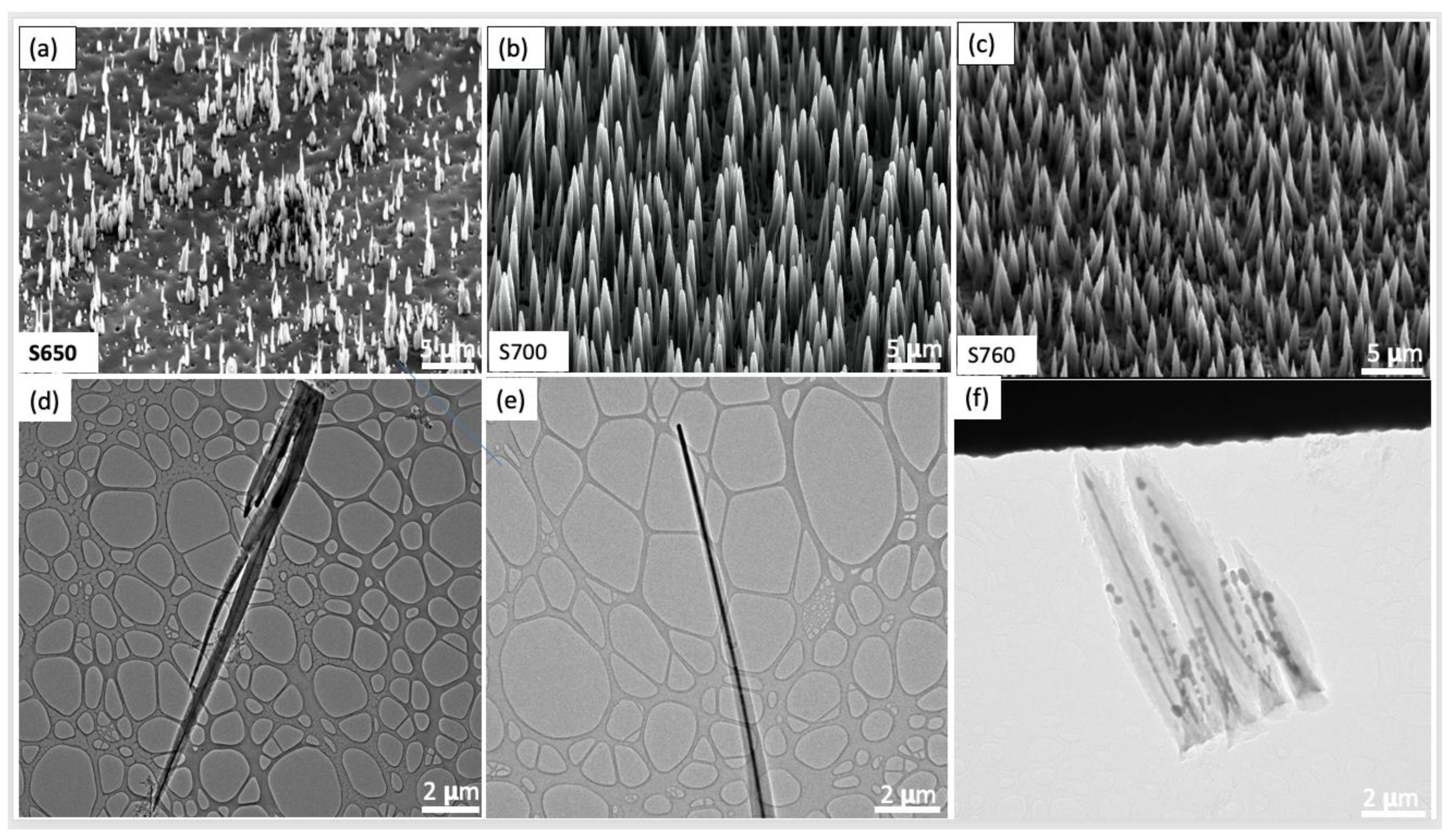
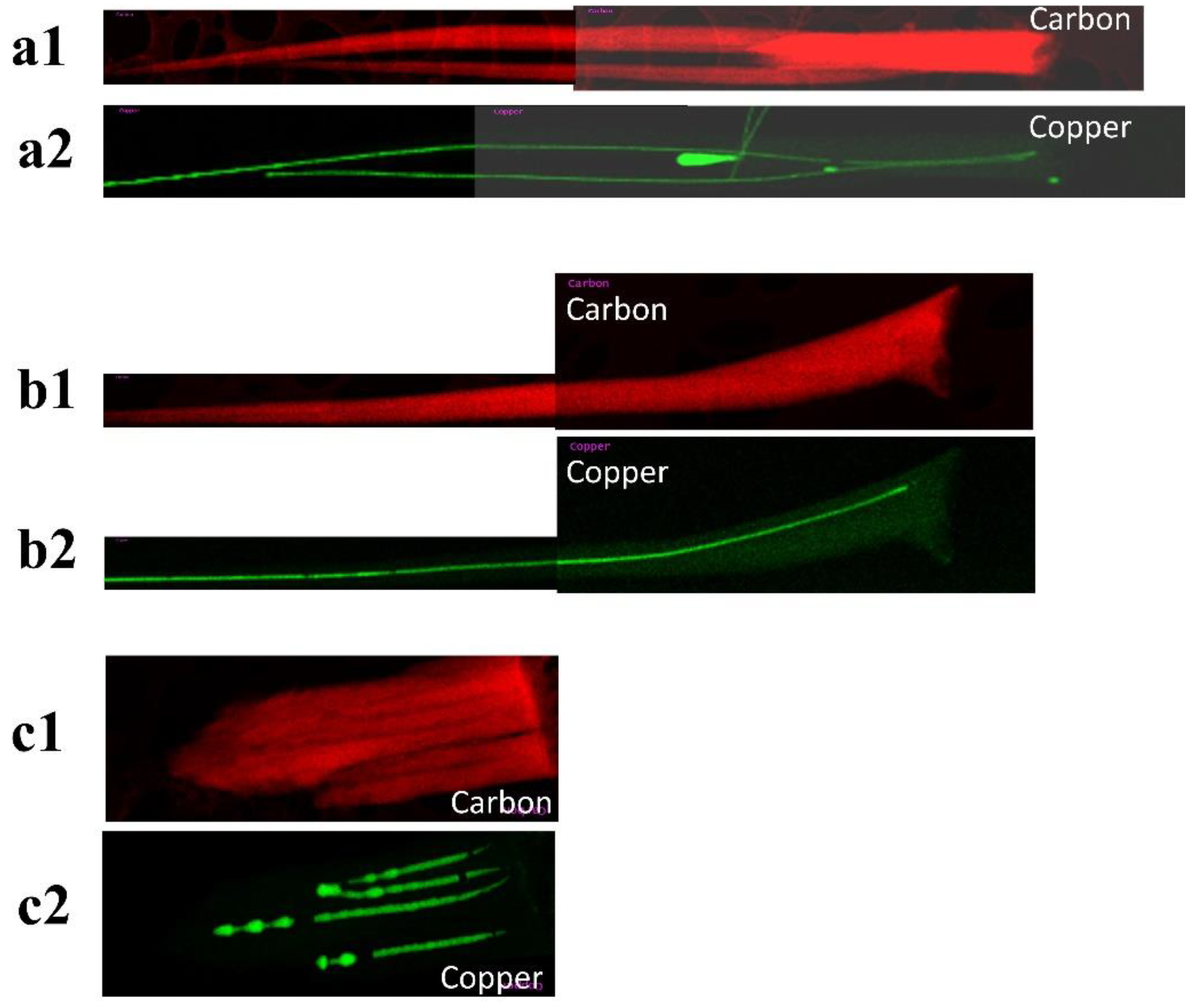

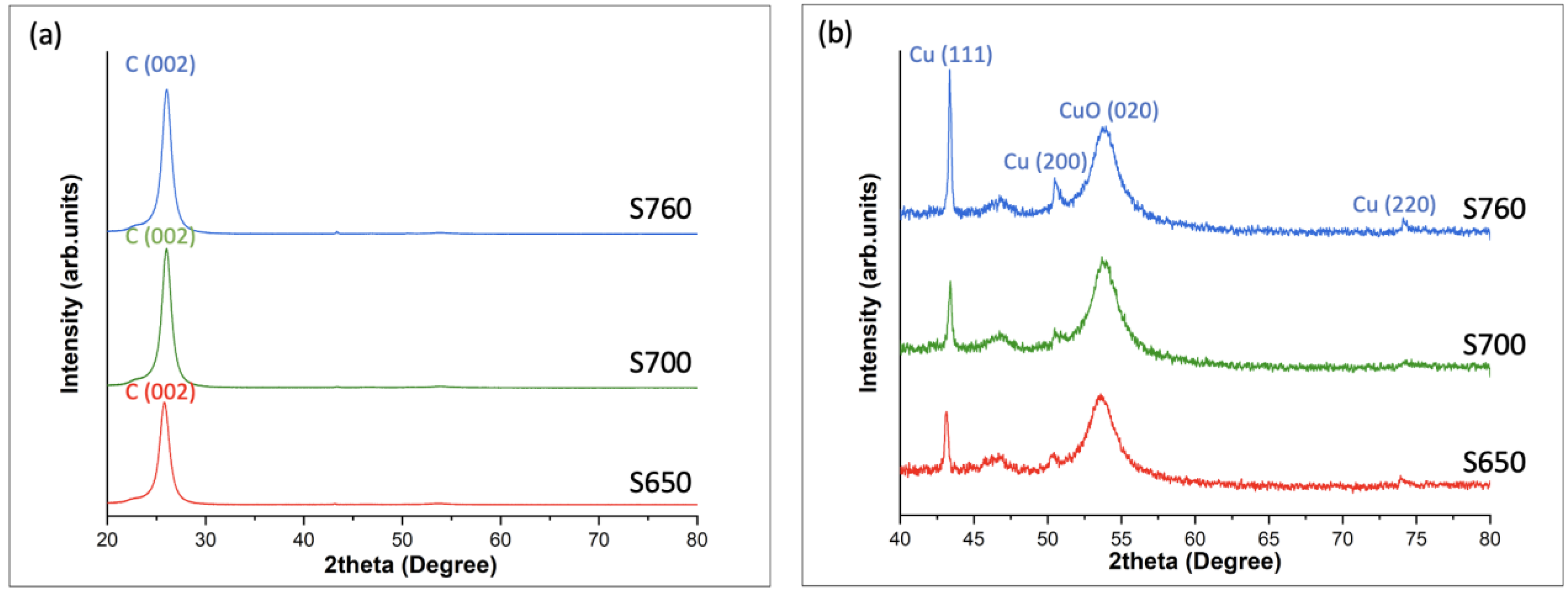
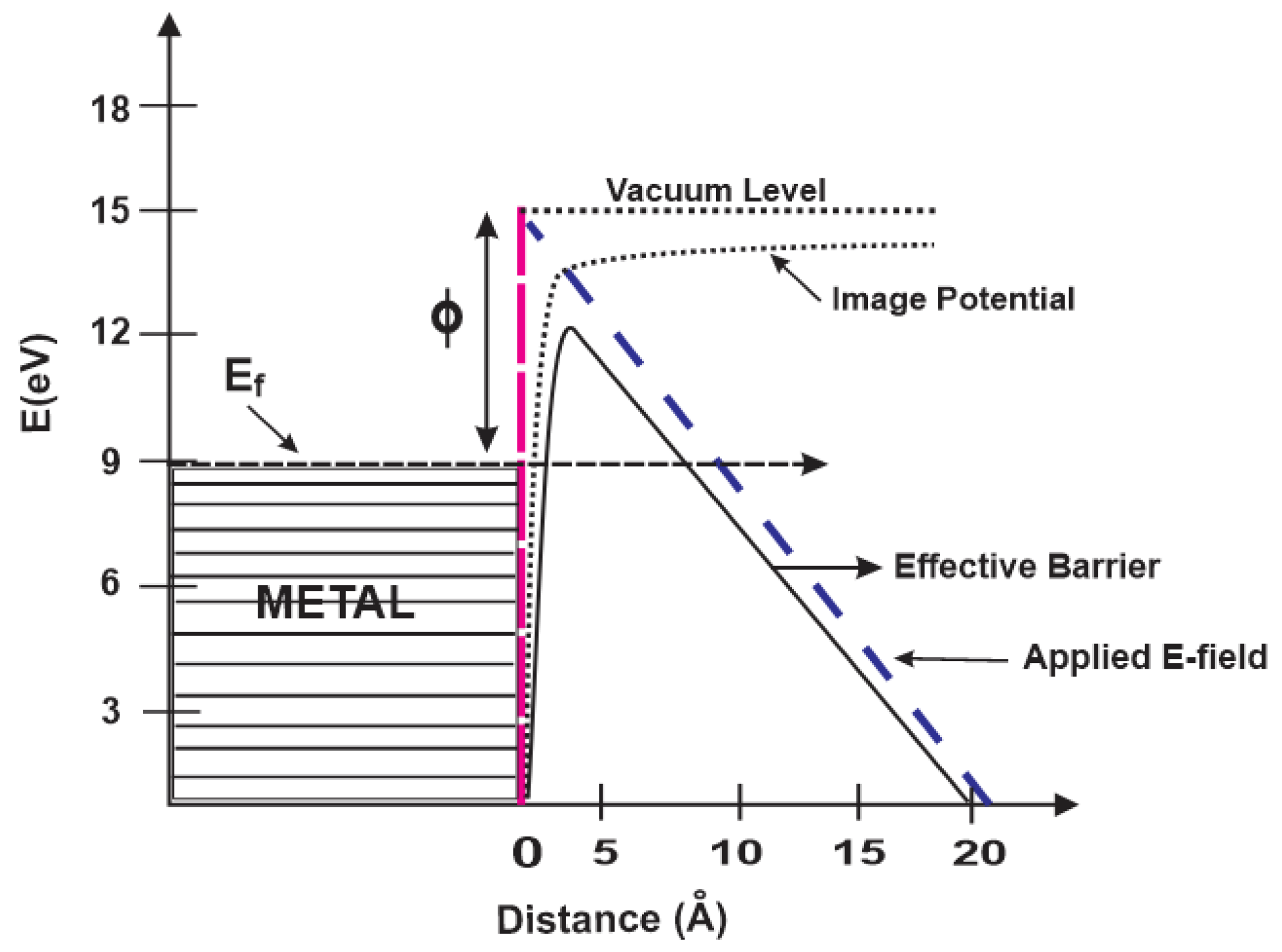
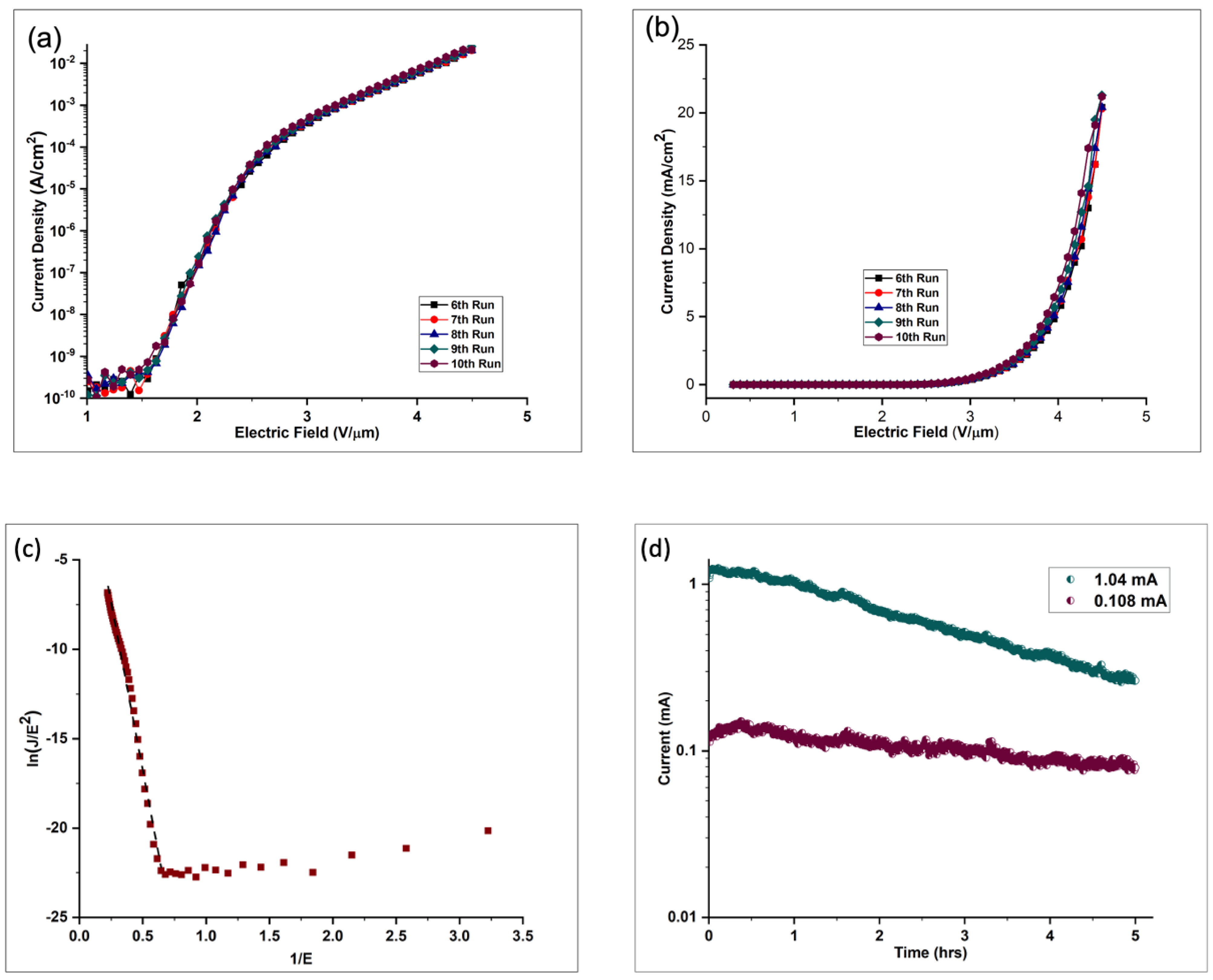

Disclaimer/Publisher’s Note: The statements, opinions and data contained in all publications are solely those of the individual author(s) and contributor(s) and not of MDPI and/or the editor(s). MDPI and/or the editor(s) disclaim responsibility for any injury to people or property resulting from any ideas, methods, instructions or products referred to in the content. |
© 2024 by the authors. Licensee MDPI, Basel, Switzerland. This article is an open access article distributed under the terms and conditions of the Creative Commons Attribution (CC BY) license (https://creativecommons.org/licenses/by/4.0/).
Share and Cite
Nwanno, C.E.; Thapa, A.; Watt, J.; Simkins Bendayan, D.; Li, W. Field Emission Properties of Cu-Filled Vertically Aligned Carbon Nanotubes Grown Directly on Thin Cu Foils. Nanomaterials 2024, 14, 988. https://doi.org/10.3390/nano14110988
Nwanno CE, Thapa A, Watt J, Simkins Bendayan D, Li W. Field Emission Properties of Cu-Filled Vertically Aligned Carbon Nanotubes Grown Directly on Thin Cu Foils. Nanomaterials. 2024; 14(11):988. https://doi.org/10.3390/nano14110988
Chicago/Turabian StyleNwanno, Chinaza E., Arun Thapa, John Watt, Daniel Simkins Bendayan, and Wenzhi Li. 2024. "Field Emission Properties of Cu-Filled Vertically Aligned Carbon Nanotubes Grown Directly on Thin Cu Foils" Nanomaterials 14, no. 11: 988. https://doi.org/10.3390/nano14110988
APA StyleNwanno, C. E., Thapa, A., Watt, J., Simkins Bendayan, D., & Li, W. (2024). Field Emission Properties of Cu-Filled Vertically Aligned Carbon Nanotubes Grown Directly on Thin Cu Foils. Nanomaterials, 14(11), 988. https://doi.org/10.3390/nano14110988






